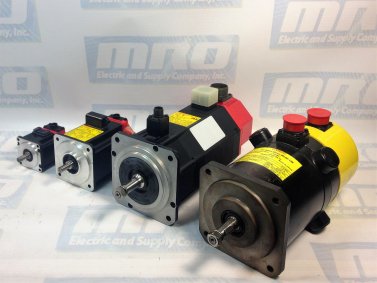Here are some basic tips on how to test a FANUC servo motor with meter or megohm meter. This procedure will show you how to troubleshoot the servo motor for shorts in windings, cables, or opens. Before starting to test, make sure to turn off all the power sources to the machine and then disconnect the 3-phase motor lines from the drive end. Visually confirm that there are no problems with the cable and then begin testing the servo motor.
How to test your servo motor for a short to ground:
Using an Ohm meter:
- Disconnect all power and amplifiers from machine. Check all three wires at T1, T2, and T3 (all three phases) to the ground wire. The readings for this should be infinite, and if it is zero or reads any continuity then there is a problem with the motor or the cable. For this disconnect the cable and check each separately. Be sure to make sure leads on both ends are not touching anything, including the other leads. Most servo motor shorts can be ready with a regular quality meter going to at least 10 megaohms.
Using a Megohm meter:
- Disconnect all power from machine. Check all three wires at T1, T2, and T3 (all three phases) to the ground wire. Reading should be between 600-2000 Megohms. Most shorts will be below 20 Megohms. Be careful not to touch the leads or the wires to anything when taking the reading because it can give a false reading. There should be about 1000 Ohms of resistance for each volt of incoming power, but this is not a standard rule. If it is 230meg to 600meg there may be deterioration in the cable.
How to test a servo motor for open or short in the windings:
Using an Ohm meter:
- Disconnect all power from the machine. Put meter on ohms and test T1 to T2, T2 to T3, and T1 to T3. The range should be between 0.3 and 2.0 ohms, with most being at about 0.8 ohms. If it is zero there is a short between the two phases. If it is an open the reading will be infinite or well above 2,000 ohms.
Cable and plug notes:
- Often times the connector on the cable to the motor will get coolant in it. You can dry it out an retest, if it is still bad the inserts will get burn marks in them and cause a slight short, so they need to be replaced. If it is a DC motor, check the brushes. There should be 3-4 round caps to remove around the motor. Under these there is a spring with a square block (brush). Check to see how much is left, they may need to be replaced.
MRO Electric has a large stock of FANUC servo motors available. If you would like a replacement or spare, or if you have any questions, please call 800-691-8511 or email sales@mroelectric.com. To check out other posts, please visit our blog page.

Updated on April 26, 2024 by Leanna Cota
hello
Im going to test stand of Fanuc servo motor .
do you have any idea about this?
i know a lot of model of Fanuc servo motor but if you information let us know
Regards